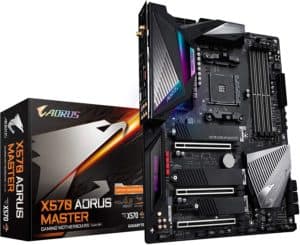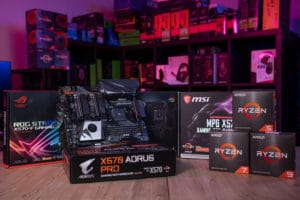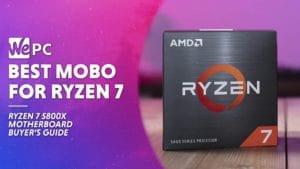Best Motherboard for Ryzen 9 5950X
In this article, we examine the five best available motherboards to pair with the AMD Ryzen 9 5950X CPU!

The Ryzen 9 5950X is the best of the 5000 series CPUs from AMD, it has a massive core count and a blisteringly fast core boost speed to boot. We need a motherboard that is able to keep up with the output of this absolute processing machine, and one that helps keep our PC as future-proof as possible. Here is the best motherboard for Ryzen 9 5950X.
The Ryzen 9 5950X is a heck of a CPU, but you need to be careful what motherboard you pair with it. After all, a 16-core multi-threaded speed-monster doesn’t play well with all others. It needs a motherboard that can stand up to its power, facilitate its functions and give you access to everything the 5950X can do.
Fortunately, we’ve collected five of the best compatible motherboards that can let you get every last ounce of pleasure out of your high-end, high-powered, high-ish priced, core-clustered titan of a CPU. We’ll talk you through the crucial specs like chipset, form factor, PCIe, and RAM to give you the facts you need to make the best decision for your needs.
If you want to stay up to date on the latest Zen 4 and AM5 news, we have articles for them both.
Our Top Picks

How Do We Choose?
The ‘We’ in WePC are a team with only two goals in mind – testing computer components till they squeak, and giving our customers the best possible component suggestions for their PC builds. We will happily debate the merits of one CPU versus another till the cows come home, get bored and put themselves to bed. You should hear our Thanksgiving arguments.
Or possibly not.
The point is, this is not our first tech revolution. We have years of experience when it comes to testing and benchmarking components, and a dedication to giving builders trusted, reliable information about what’s out there, what’s good, what’s bad, why it works or doesn’t. We know our stuff, and we know you know yours too – so we choose the products we feature based on hard data and the metrics that matter to you.
All the motherboards we feature here are worth your time – they have to be. Nobody wins if we give you useless information, right? Now, the truth is always going to be that Your Mileage May Vary – there are other motherboards out there you can pair with the Ryzen 9 5950X, but with our years of benchmarking experience, these are the 5 we’re most eager to tell you about because they’re the 5 we think will give you the best experience if you pair them with the 5950X* (*Correct at time of writing).
Things To Consider
So if we’re convinced we have the top 5 best motherboards for the Ryzen 9 5950X, what criteria are we looking at? What should you take into consideration before you hand over your hard-earned cash?
Form Factor
Without a doubt, when it comes to motherboards, you need to look at the form factor. Some people think of that as the skeleton of the board, but that’s a little simplistic. The form factor is more like the genome of the board. It’s the blueprint, the details of what is possible for the board. It sets the boundaries of what the board can deliver, including how many ports it has, where its mounting holes are, and so on. It also covers the basics like the overall board dimensions, so knowing the form factor gives you the genetic map of the board. If the form factor doesn’t fit your build, toss the board you’re considering and go with something else that does meet your needs.
Normally, you’d be checking the small print on the form factor of a board, to make sure it was compatible with your CPU. We’re delighted to save you all that squinting. To get in the door of this review, all the boards have to be compatible with the Ryzen 9 5950X.
You’re welcome. This stuff is our passion too, remember?
The joy of motherboards compared to…well, almost every other component of your build (except mmmaybe, at a pinch, cooling systems), is that they grow old gracefully. Where every year will probably bring at least a couple of new CPUs and GPUs that will make you want to sell your grandma to afford, if you buy a motherboard that’s up to current expectations, you can expect to keep it around a good while. Which…y’know…frees you up to buy all the latest GPUs and cooling system add-ons…
The standard form factor across all manufacturers these days – as you’ll probably already know if you’re reading this – is the Advanced Technology Extended (ATX). Which are great if you’re doing tower builds.
If you’re not doing tower builds, lots of people go with the handy micro ATX options, which are handily smaller in size, but maddeningly also feature fewer expansion slots. ITX motherboards are especially useful – we hesitate to use the word cute – if you’re looking to build a small PC.
Processor Socket
The processor socket and the chipset are usually like an old married couple when people talk about their builds. They go together because they describe some of the most vital pieces of your build, and they determine what CPU you can add to your board.
Again, here, we’ve saved you some steps of searching and squinting. While AMD processors usually require either an AM3 or AM4 processor socket, the 5950X really needs an AM4. We’ve chased all AM3-socketed boards out of the office on your behalf, so you can be sure of a good match if you choose any of the boards we feature here. If you want to learn about motherboards and how they work, check out our ‘what is a motherboard‘ page.
Chipset and PCI Slots
You want to cut a little to the chase? When it comes to chipsets and PCI slots, go PCle 4.0. Accept no substitutes. Sure, right now you might be able to get by with a PCle 3.0, but right now isn’t going to stay right now very long. The PCle 4.0 is coming, and by switching to it now, you assure yourself a motherboard that will be working with enhanced high-speed gaming PCUs for years to come.
The chipset in a motherboard helps different components exchange data. Going for anything less than a PCle 4.0 at this point is a false economy in the long run when PCle 4.0 is available.
Naturally, all the motherboards reviewed here have a PCle 4.0 chipset, so they’ll all give you future-proofed data exchange speeds.
RAM
To support RAM, a motherboard needs RAM slots. The number and type of RAM slots your board has determine how RAMmed the board can be. Motherboard RAM is listed as DIMM, and when you’re looking to buy a motherboard for a CPU as highly spec’d as the 5950X, you have options at DDR3 or DDR4.
As we learned with PCle chipsets though, right now 4 is the magic number. DDR4 is newer (and therefore more future-proof) and offers you a better specification of motherboard all round. Go 4. You’ll thank us as games get faster and more RAM-hungry. You won’t be surprised to learn that all the boards that made it to our winners’ circle are packing DDR4 RAM. We’d love to tell you that’s because we love you and we’re just generous, but really it’s because we take this stuff seriously, and DDR4 performs the socks off all other options.
SATA and NVMe
The SATA 3 ports that feature on a motherboard are the board’s windows to external worlds. HDDs, and increasingly, SSDs connect this way. What does that mean? Storage, storage, and more storage. You need storage. Everyone needs storage. Even if you don’t think you need storage right now, believe us – we have wise heads on young shoulders – you’re gonna need the storage.
As well as SATA ports, if your board has NVMe slots, you’re in a whole other league. NVMe is what SSDs dream of being when they grow up and get stock options. It loads and responds at rates which even SSDs – which still think they’re the new kid on the block, with speeds that make HDDs feel sad and unloved – can only dream of. SATA 3 ports and NVMe together make for a sweet, speedy set-up, so all other things being equal, nab yourself a board with NVMe. Not all the boards on our list give you NVMe technology – but at least a couple of them do, including our list-leader.
Features
Finally, when you’re buying a motherboard, check out its feature-list to see what additional benefit it brings you. That’s advice that works both ways. On the one hand, if it includes some built-in capacities, it means you don’t have to pay out for additional components, like on-board audio. On the other hand, you’re builders, so the chances of you necessarily being content with anything that comes built-in, when there are add-on options that can be bought and are higher-spec is probably fairly limited. So buy a board that gives you extras you like – but don’t pay extra for built-ins you’re going to want to get round or supersede in any case.
The Best Motherboard for Ryzen 9 5950X
In-depth Review

- AM4, PCle 4.0, and NVMe make it a highly futureproof board
- XMP capable, to make the most of the RAM
- DDR4 RAM
- Fins-array heatsink and a direct touch heatpipe
- ESS SABRE DAC Audio
- Expensive board
The Gigabyte x570 AORUS motherboard is at the pricier end of our spectrum here, but what you get for the money turns it into a pretty fair value proposition. ATX-supported, it weighs in at 4.85lbs, which for a motherboard means it’s also on the hefty side. So what does it deliver for all that seemingly excess weight?
Well, first and foremost, it brings DDR4 RAM to your gaming party, and there are 4 memory slots available, which should be enough to give you all the RAM you can cope with. An AM4 socket, NVMe tech, and a PCle 4.0 socket give you some serious future-proofing and allow the 5950X to show off its modern multi-threaded, core-heavy tricks. Dual-channel ECC is a cool addition, and the combination of a fins-array heatsink and a direct touch heat pipe is impressive in this board.
The extra joy about this motherboard though – and one of the things that propel it to the top of our list here – is that while it’s chunky, it focuses a lot on the speed of operation. You can work this board up to 4400MHz, and, because sure, why not, it’s also XMP capable.
High-speed networking is at your fingertips here too, with Intel Wifi-6. And while we’d normally say a motherboard probably needs an add-on sound system, the AORUS comes with ESS SABRE DAC Audio fitted. Sure, you’re builders, but as an out-of-the-box offering, that’s more than a decent beginning. You could get through many years of the motherboard’s life without needing to ramp that up, which is a thing to be grateful for once you’ve paid the price for the 5950X and then added the extra cost of the board.
Interested in voltage regulation stats? Sure, why not? The AORUS comes with 14 Direct Phase VRM. We know, we know, more doesn’t always mean better when it comes to VRMs. But all the benchmarking seems to show the 14 Direct Phase VRM is more than good enough for even the most modern gaming uses, and if you pair it with a modern CPU like the 5950X, you could be in for some truly fun overclocking.
What are we looking at for cooling systems? How about a Smart Fan 5? Hybrid fan headers are pretty up to date, and the Smart Fan’s also compatible with liquid cooling, when you get your breath back and save some more dollars.
Bottom line, then, yes, you’ll pay through the nose for the AORUS. If you’re in the market for a new motherboard to help your Ryzen 9 5950X do all the tricks it can do, though, the AORUS is a high-value proposition even at its price-point. The heatsink options, the NVMe, the future-proofing sockets, the XMP capability to unlock every last ounce of RAM you have, and an above-decent built-in audio offering make the X570 AORUS our top pick for a board to enable and enhance the capabilities of your Ryzen 9 5950X.

- Futureproofed with AM4 socket, PCIe 4.0, DDR4 RAM, and NVMe
- On board wifi
- One of the best cooling systems at the price
- Two M.2 drives
- TUF protection
- Significantly lighter than our leading board, so you’re not going to sprain anything carrying your completed build
- Only one of the NVMe slots features a heatsink
Balance. That’s the keynote of the Asus AM4 TUF Gaming X570-Plus motherboard. A mid-high feature set, balanced with a less breath-taking price-point than some boards, means it’s likely to end up in many builder’s itchy hands, especially when they have a spanking new 5950X to play with.
Want a quick guided tour of some of the X570-Plus’ selling points?
You’re looking at a board with an AM4 socket, with DDR4 RAM, with NVMe, and with PCle 4.0, so point 1 – this is a board that intends to stick around a while.
ATX-supported, you’re talking about a board that’s 13.31 x 10.74 x 2.68 inches and weighs a total of 2.56lbs – significantly lighter as a baseboard than the AORUS. Exclusive gigabit ethernet and TUF protection? No problem – boom, there you go. 2x SATA cables for speedy data exchange with other components. Having NVMe included is a big bonus at the price-point, though – and this detracts from its fight for the top spot – only the second NVMe slot features a heatsink. Quite what gives there, we’re not sure, but it could be part of that balancing act that lets the X570-Plus offer a little of everything without overloading its price-point. The board also comes with 2x M.2 drives and a USB 3.2 Gen 2.
The X570-Plus even has its own wifi fitted. In terms of cooling systems, it delivers one of the best options at its price-point, with an M.2 heatsink, Fan Xpert 4, and hybrid fan headers.
Overall, while it may have perhaps the odd bell missing and be whistle-poor in some areas, it’s still able to sing and dance at a level that will help you make the most of your 5950X, and without leaving you short on taco-money for the month. That combination of feature-richness and reasonable economy is what puts it up at number two on our list of best motherboards for the Ryzen 9 5950X.
- Price – it’s the least expensive motherboard featured
- Top-quality thermal solution
- Lightning Gen 4 M.2
- PCle 4.0, AM4, and DDR 4 RAM give the board some serious futureproofing
- No Wifi-6 on this board
The MSI B550M PRO-VDH is the least expensive motherboard on our list which is terrific – but does the cheapness lead to a compromise in terms of making the most of the Ryzen 9 5950X?
The B550M is an ATX board, measuring 9.6 x 9.6 x 1.5 inches and weighing just 2.46lbs. That’s a set of dimensions that means it also supports Micro ATX if you’re building smaller rigs.
Nevertheless, it’s up to date with an AM4 socket DDR4 RAM and 4 separate memory slots, giving you a capacity of up to 128GB. It also keeps determinedly up with the Joneses, bringing PCle 4.0 readiness to your build. At the price-point, it’d be difficult – not to say downright cheeky – to ask for much more than that. In chipset terms, this board uses AMD B550. But you probably already knew that from the name, right?
Lightning Gen 4 M.2, M.2 Shield Frozr, and AMD Turbo USB 3.2 Gen 2 are by no means shabby in a board this budget-friendly, and the B550M supports all AMD 3rd Generation Ryzen CPUs – up to and including the 5950X, using a long-familiar Windows 10 platform. And again, while audio units are among some of the things builders most like to strip out and add on from the aftermarket selection, the B550M gives you an audio boost function built-in, which should at least get you started and improves in-game audio effects.
For a board of this size and price, the B550M’s cooling solution is pretty top-notch, giving you a heat sink thermal pad to chill your PC the heck out even under a pretty intense load while gaming. By way of full disclosure though, while it delivers all this at a relatively friendly price, one area where you lose out is in wifi – there’s no wifi-6 on this board.
Nobody’s going to try and tell you that MSI is a megastar motherboard manufacturer. But in terms of delivering quite a lot of what you want without dropping an atom bomb on your bank account, it’s definitely an option worth considering.
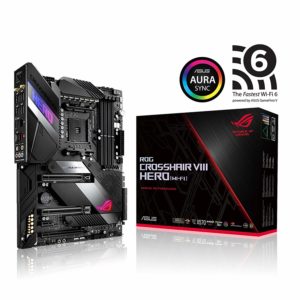
- AM4, DDR 4, and PCle 4.0 for advanced futureproofing
- Two M.2 Drives
- PCIe 4.0
- Lots of add-in features and functions, including intel gigabit ethernet
- Water cooling zone in a well-developed cooling system
- Size – allows smaller rig-builders to use the potential of the 5950X
- Highest price-point in the list delivers a mini-build
From the least expensive to the most expensive board on our list. The Asus ROG Crosshair VIII Impact Motherboard will cost you a lot of upgrade money – the question is whether it’s worth it.
The answer, again, is yes and no. Yes, it’s high-spec and rich in features. But when compared with some of the other motherboards on our list, it fails to convince of its value as much as some others.
That said, if you’re looking to take your gameplay to another level, it’d be difficult to see how you’d better the Crosshair VIII – especially if you want to squeeze maximum gameplay out of a mini-build.
Yes, that’s right – unlike the other boards on our list, the Crosshair VIII is Mini ITX-supported. Small-builders, rejoice! There’s a mini-board that can help you access all the power of the 5950!
For all its small-build cred though, it comes in at 12 x 9.6 x 2.2 inches and weighs 4.10lbs, which is seriously heavy for a smaller board. It’s the Middle Earth Dwarf of our collections – small, heavy, but intensely powerful for its size, and you overlook it at your peril.
The contradictions of the Crosshair VIII keep on coming – which is something of a pleasure in itself. Yes, it’s a small board, but it’s slightly bigger than most small boards, which means – bingo! Two-slot graphics cards are A-OK here, which is an important consideration for gamers – especially when you’re looking for GPUs to pair with your Ryzen 9 5950X!
Futureproofing elements here include an AM4 socket, DDR4 RAM, and PCle 4.0 – see what we mean? Small, but surprisingly mighty. Four memory slots give you a maximum RAM of 128GB too – again, the smaller board is up there with the big boys when it comes to some key components of its build.
Delightfully, you can overclock the DDR4 memory by a significant amount, for faster gameplay, and you also get a highly effective cooling system and a combo chipset heatsink into the bargain. Double-capacity DIMM Support and two M.2 drives come built-in too, as well as Bluetooth 5.0 and a water cooling zone. Sure – go overclocking nuts, you wild and crazy game-fiends!
Still not quite enough to justify the price-point? How about if Asus threw in RGB headers, aura sync RGB, and intel gigabit ethernet? Would that seal the deal? How about if the small board supported Gamefirst V technology and came with, let’s say, 2 addressable headers?
That’s a heck of a lot of technical elements in a smaller board. Whether they add up to a must-buy at the price-point of the Crosshair VIII will be down to the build you’re particularly keen to make. But as a smaller board that can handle the 5950X, it might well be irresistible to lots of small-rig builders.
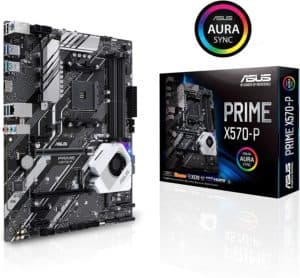
- DIMM RAM technology
- PCIe 4.0
- Great for memory overclocking
- Fan Xpert 4 for cooling
- Highly customizable board
- Could feel basic for some higher-level builders, lacking many additional features
The Asus Prime X570-P is another motherboard that strives for balance between features and price. If anything, the reason it’s so low down our list (but still better than most motherboards out there for integrating the Ryzen 9 5950X) is because it errs on the side of price, and leaves its feature-build feeling a little on the light side.
After a walk on the small side, we’re back to full size with the X570-P. It’s an ATX-supported board, coming in at 10.35 x 12.92 x 2.09 inches, and weighing a neatly light 2.65lbs.
Like the rest of our boards, you’re looking at an AM4 socket, RIMM DDR4 RAM, and a PCle 4.0, so there’s decent futureproofing in the board, so you’re not throwing your money away on a board that’s about to go defunct.
An AMD 570X chipset and a maximum RAM of 128GB puts it up and fighting for its place with some of our list-leaders. In terms of next-gen connectivity, the X570-P also features Dual M.2 support, SATA, and USB 3.2 Gen 2 ports (which allow for backward-compatibility – a neat feature if you’re not about to throw out all your prior components).
With a memory speed of 2133 MHz, and access to Asus Optic-MEM (Ohhh, the overclocking fun!), it’s more than respectable in the market, especially given what you’ll pay for boards with harder-core feature-sets. The X570-P doesn’t skimp on cooling or heatsink features either – Fan Xpert 4 is here to help cool your overclocked system and keep it running fast and smooth.
This is where the story starts to look thin. Compared to some higher-scoring boards, the X570-P is light on extra features. It does come with an Aura Sync RGB header and next-gen addressable RGB strips, which might well be enough to sell it as the board of choice to some builders. Others, looking to pimp their build a bit more, might find it lacking in fundamental elements. That said, the X570-P is a hiiiiighly customizable board, and the reasonable price-point means you’re likely to have some cash leftover to give it a little of your personal pizazz beyond its basic build.
Final Word
When buying a motherboard to match with a particular CPU, there’s usually a lot of checking to do – are the two compatible, does it contain futureproof technology, does it actually let you unlock the power of the CPU, etc.
We’ve done all that, so if you have a Ryzen 9 5950X and you’re looking for a motherboard to pair it with, you don’t have to worry about it.
Each of the boards in our list is the perfect choice for someone building a rig with a 5950X in it. Each of them will help you access its core-heavy, thread-demented processing power and translate it into hardcore gaming joy.
Which of the boards is right for you depends less on the boards, and more on what you want your build to be able to do. It also of course depends on how much motherboard cash you have and are willing to spend.
But every board here is futureproofed as much as it can possibly be. AM4 sockets, DDR4 RAM, PCle 4.0, and wherever possible, NVMe data transfer mean all of these boards would be a solid investment, helping you get the most out of your new CPU.
Ultimately then, your choice comes down to personal style, additional features – to wifi, or not to wifi? – particulars of cooling systems and overclocking potential, and whether you’re building a tower system, a smaller system, or a mini-system.
Either way, there’s a motherboard on our list for you. Grab your 5950X, check out these boards, and build happy.
WePC is reader-supported. When you buy through links on our site, we may earn an affiliate commission. Prices subject to change. Learn more

